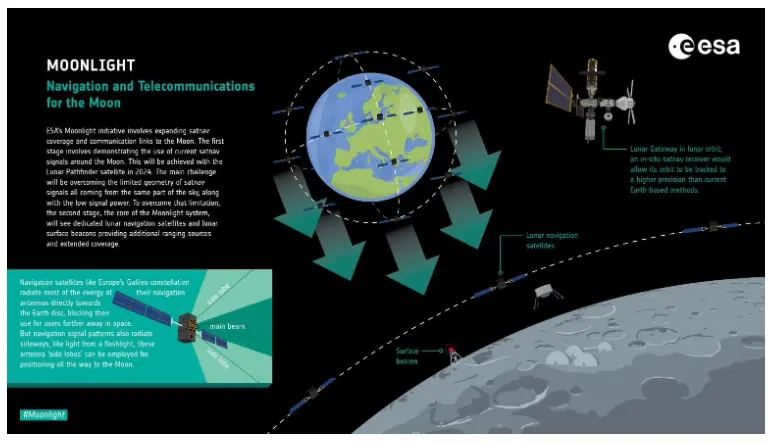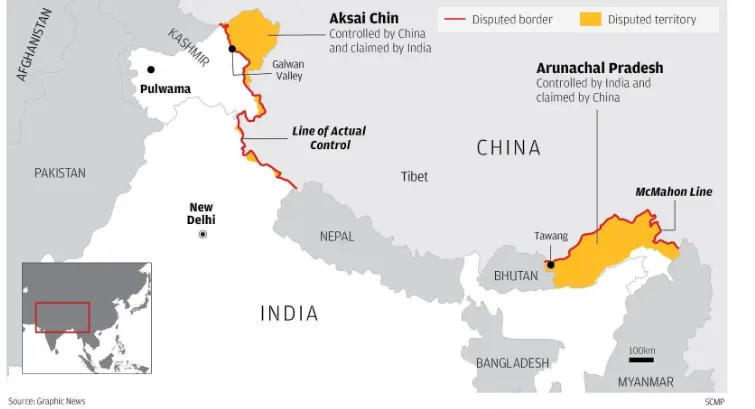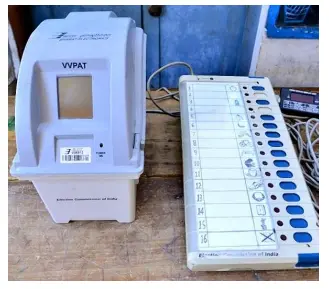Wednesday, 17th April 2024
Asia Development Outlook Report 2024
In News: In its April 2024 release, the Asian Development Bank (ADB) updated its Asia Development Outlook Report, revising India's Gross Domestic Product (GDP) growth forecast for fiscal years (FY) 2024 and 2025.
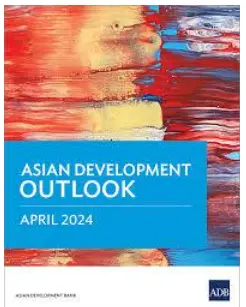
Key Highlights of Asia Development Outlook Report 2024
Asia’s Growth Outlook
- Despite uncertain external prospects, Asia is projected to maintain resilient growth.
- Factors include the conclusion of interest rate hiking cycles and a sustained recovery in goods exports.
- GDP growth forecast for 2024 stands at 4.9%, with a similar projection for 2025.
- Inflation expected to moderate to 3.2% in 2024 and further decrease to 3.0% in 2025.
India’s Growth Forecast
- India's investment-driven growth positioned it as a major economic engine in Asia.
- GDP growth projected at 7% in FY 2024 and 7.2% in FY 2025.
- Factors fuelling growth include higher capital expenditure, rising private corporate investment, and strong performance in the service sector.
- FY 2025 expected to witness increased momentum driven by improved goods exports and enhanced manufacturing productivity.
Risks and Challenges
- Unanticipated global shocks and weather-related impacts on agriculture remain key risks.
- Current account deficit projected to widen moderately due to rising imports.
Sectors Driving Asia’s Growth
- Economic powerhouse with several fast-growing economies.
- Home to dominant manufacturing hubs benefiting from skilled labor forces and efficient infrastructure.
- Active involvement in international trade and regional trade agreements like RCEP.
- Emerging as major financial centers attracting investments and fostering entrepreneurship.
India’s Contribution to Asia’s Growth
- Promotion of regional connectivity through initiatives like INSTC and India-Middle East-Europe Corridor.
- Active promotion of renewable energy initiatives through the International Solar Alliance.
- Capacity-building efforts through the ITEC program.
- Introduction of UPI services in Asian countries, enhancing digital transactions efficiency.
|
UPSC Previous Year Questions Prelims (2020) Q. Consider the following statements:
Which of the statements given above is/are correct? (a) 1 and 2 only Ans: (b) Prelims (2009) Q. Which one among the following South Asian countries has the highest population density? (a) India Ans: (a) Prelims (2016) Q. The term ‘Regional Comprehensive Economic Partnership’ often appears in the news in the context of the affairs of a group of countries known as (a) G20 Ans: (b) Mains (2016) Q. Evaluate the economic and strategic dimensions of India’s Look East Policy in the context of the post-Cold War international scenario. |
Source: ADB
Custodial Death
In News: The Supreme Court has underscored the importance of taking a "more stringent approach" when evaluating bail requests from police officers accused in incidents involving custodial deaths.
Understanding Custodial Death
Custodial death pertains to the demise of an individual while under the custody of law enforcement agencies or correctional facilities. This unfortunate event can occur due to various reasons such as excessive force, neglect, or abuse by the authorities.
Types of Custodial Death
- Death in Police Custody: Occurs due to factors like excessive force, torture, denial of medical care, or other forms of abuse.
- Death in Judicial Custody: Resulting from issues like overcrowding, poor hygiene, lack of medical facilities, violence among inmates, or suicide.
- Death in the Custody of Army or Paramilitary Forces: Could be due to torture or extrajudicial killings.
Importance of Addressing Custodial Deaths
- Violation of Human Rights: Custodial deaths infringe upon the basic rights of individuals to fair treatment under the law.
- International Obligations: India's commitment to international conventions like the United Nations Convention Against Torture (UNCAT) necessitates stringent measures to prevent custodial violence.
- Impact on Extradition Cases: Weak regulations on custodial torture can impede efforts to extradite individuals evading legal proceedings.
- Mental Health Concerns: Custodial violence can have detrimental effects on the mental health of individuals, leading to cruel behaviour and abuse.
Constitutional and Legal Framework
- Constitutional Safeguards: Articles 20 and 21 of the Indian Constitution guarantee protection against arbitrary punishment and the right to life, respectively.
- Legal Provisions: Sections of the Indian Evidence Act, Indian Penal Code, and Criminal Procedure Code provide legal protections against custodial violence.
International Conventions Against Custodial Torture
- International Human Rights Law: Contains provisions prohibiting torture and enforced disappearances.
- United Nations Charter: Emphasizes treating prisoners with dignity and upholding their fundamental freedoms.
- United Nations Convention Against Torture (UNCAT): Aims to prevent acts of cruel, inhuman, or degrading treatment or punishment worldwide.
Measures to Combat Custodial Torture
- Strengthening Legal Systems: Enactment of comprehensive legislation criminalizing custodial torture and ensuring impartial investigations and fair trials.
- Police Reforms and Sensitization: Enhancing police training programs to prioritize human rights and professionalism.
- Empowering Civil Society and Human Rights Organizations: Advocating for victims, expanding the jurisdiction of human rights commissions, and providing support to affected individuals and families.
- Collaboration with International Bodies: Engaging with international human rights organizations to seek justice and redress for victims of custodial violence.
|
UPSC Previous Year Questions Mains (2014) Q.1 Instances of the President’s delay in commuting death sentences have come under public debate as a denial of justice. Should there be a time specified for the President to accept/reject such petitions? Analyse. Q.2 The National Human Rights Commission (NHRC) in India can be most effective when its tasks are adequately supported by other mechanisms that ensure the accountability of a government. In light of the above observation assess the role of NHRC as an effective complement to the judiciary and other institutions in promoting and protecting human rights standards. |
Source: IE
Government Reviews RERA Functioning
In News: The Ministry of Housing and Urban Affairs is currently undertaking a review of the operations of the Real Estate (Regulation and Development) Act, 2016.

About RERA
- The Real Estate (Regulation and Development) Act (RERA) is a significant legislation enacted by the Government of India in 2016.
- Its primary objective is to regulate the real estate sector and promote transparency, accountability, and efficiency in real estate transactions.
- RERA aims to protect the interests of homebuyers and promote fair practices in the real estate industry.
Need for RERA
- Securing the Largest Investment Sector: Regulation of the real estate sector has been under discussion since 2013, and the RERA Act eventually came into being in 2016.
- Data show that more than 77% of the total assets of an average Indian household are held in real estate, and it’s the single largest investment of an individual in his lifetime.
- Creating Accountability: Before the law, the real estate and housing sector was largely unregulated, with the consequence that consumers were unable to hold builders and developers accountable.
- The Consumer Protection Act of 1986 was inadequate to address the needs of homebuyers. RERA was introduced to ensure greater accountability towards consumers, to reduce frauds and delays, and to set up a fast track dispute resolution mechanism.
Major Provisions of RERA
- Establishment of State-Level Regulatory Authorities (RERA)
- Establishment of Real Estate Appellate Tribunal
- Mandatory Registration of Projects
- Deposits in Escrow Bank Account
- Developer’s Liability for Structural Defects
- Penal Interest in Case of Default
- Cap on Advance Payments
- Carpet Area Pricing
- Punishment for Violation
Implementation of RERA
- All States/ UTs have notified Rules under RERA except the State of Nagaland.
- 32 States/UTs have set up a Real Estate Regulatory Authority and 28 States/UTs have set up a Real Estate Appellate Tribunal.
- 1,01,304 Real Estate Projects & 72,012 Real Estate Agents have been registered under the provisions of RERA.
- 1,06,657 complaints have been successfully disposed of by the Real Estate Regulatory Authorities across the country.
Reasons for Government Reviewing RERA
- Assessment of Effectiveness
- Data Collection
- Uniformity and Compliance
- Possible Amendments
|
UPSC Previous Year Questions Mains (2020) Q. “The growth of cities as I.T. hubs has opened up new avenues of employment, but has also created new problems”. Substantiate this statement with examples. Mains (2013) Q. Discuss the various social problems which originated out of the speedy process of urbanisation in India. |
Source: IE
Pompeii
In News: Recently, archaeologists discovered a banquet hall in Pompeii with black walls adorned with vibrant frescoes depicting scenes from Greek mythology.
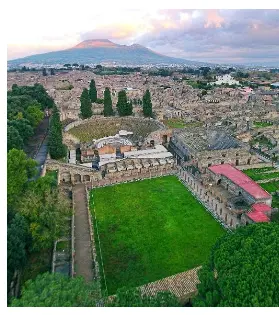
The Ancient City of Pompeii: A Window into Roman Life
- Pompeii is situated near modern-day Naples, Italy, and lies at the southeastern base of Mount Vesuvius.
- Originally settled in the Bronze Age, Pompeii was built on a spur formed by a prehistoric lava flow, positioned at the mouth of the Sarnus (modern Sarno) River.
- In 80 BCE, Pompeii was conquered and absorbed into the Roman Empire.
- At its zenith, Pompeii boasted a thriving economy driven by trade and agriculture, with an estimated population of 10,000 to 12,000, of which one third were slaves.
- The city featured advanced amenities such as a complex municipal water system, an amphitheater, and a gymnasium.
- Pompeii met its tragic fate when it was buried in volcanic ash during the eruption of Mount Vesuvius in 79 CE.
- Rediscovered in 1748 after being lost and forgotten, Pompeii's exceptional state of preservation offers invaluable insights into Roman daily life.
- Recognized as a UNESCO World Heritage Site, Pompeii stands as a testament to the rich history and culture of the ancient Roman civilization.
Source: TOI
Long Period Average
In News: According to the India Meteorological Department (IMD), India is forecasted to experience an "above normal" monsoon season, with rainfall reaching 106% of the long period average.
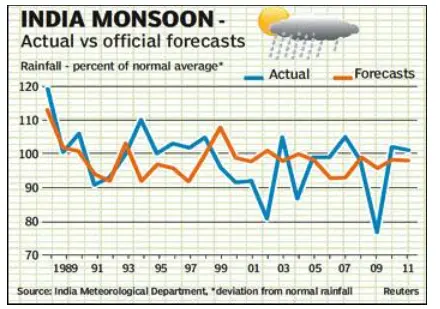
Understanding Long Period Average (LPA) of Rainfall
- Definition and Purpose
- The Long Period Average (LPA) of rainfall refers to the average rainfall recorded over a specific region for a designated time frame, typically 30 or 50 years.
- It serves as a benchmark for predicting the quantitative rainfall for that region during a particular month or season.
- Calculation and Updating
- The Indian Meteorological Department (IMD), responsible for monitoring rainfall in the country, establishes the LPA based on data spanning 50 years.
- This LPA is periodically updated, usually once every decade, incorporating the latest data from rain gauge stations.
- For example, the current LPA for all India south-west monsoon rainfall, based on data from 1971 to 2020, stands at 868 cm.
- Historical LPA Values
- Previous LPAs calculated by the IMD include 88 cm for the 1961-2010 period and 89 cm for the 1951-2000 period.
- At the national level, the annual LPA has been reduced from 117 cm to 116 cm.
- Importance of LPA
- Annual rainfall exhibits significant variability across regions, months, and years, making accurate predictions challenging.
- The LPA smooths out trends, providing a more reliable basis for forecasting by accounting for anomalies such as El Nino, La Nina, periodic droughts, and extreme weather events attributed to climate change.
- A 50-year LPA is particularly valuable as it accounts for large variations caused by unusual years of high or low rainfall, ensuring a comprehensive perspective.
- IMD Rainfall Distribution Categories
- Normal or near normal: Actual rainfall within +/-10% of LPA, i.e., between 96-104% of LPA.
- Below normal: Actual rainfall below 90-96% of LPA.
- Above normal: Actual rainfall between 104-110% of LPA.
- Deficient: Actual rainfall less than 90% of LPA.
- Excess: Actual rainfall exceeding 110% of LPA.
Source: HT
About Sudan
In News: UN Secretary-General Antonio Guterres recently stated that the indiscriminate assaults targeting civilians in Sudan may amount to "war crimes and crimes against humanity."
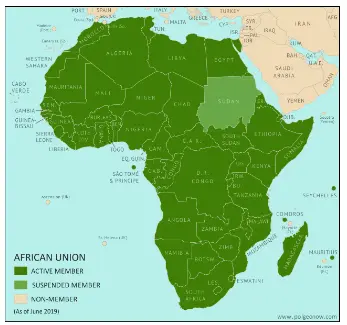
Overview of Sudan
- Location and Size
- Sudan is situated in northeastern Africa.
- It ranks as the third largest nation in Africa, covering an area of 1,886,068 sq. km.
- It shares borders with seven neighboring countries: South Sudan, Ethiopia, Eritrea, Egypt, Libya, Chad, and the Central African Republic.
- Sudan boasts a significant coastline along the Red Sea, providing crucial access to the Indian Ocean and the Mediterranean Sea via the Suez Canal.
- Geography
- Sudan is predominantly characterized by vast plains and plateaus drained by the Nile River and its tributaries.
- Much of its terrain comprises deserts and arid grasslands, with limited vegetation.
- The northern region features the Nubian Desert, primarily a rocky desert area.
- Independence
- Following Egyptian occupation in the early 19th century, Sudan was established as an Anglo-Egyptian territory under British colonial rule.
- Independence from Anglo-Egyptian co-rule was achieved in 1956.
- Since independence, military regimes inclined towards Islamic-oriented governance have dominated Sudanese politics.
- Capital and Demographics
- Khartoum serves as the capital of Sudan.
- The population is predominantly Muslim, and many Sudanese identify themselves as "Arabs."
- Languages
- Arabic is the official language of Sudan.
- English is also widely spoken and holds official status.
Source: Al Jazeera
New goverment must fix India’s food systems
In News: A recent article emphasizes the critical need for future governments to prioritize boosting agricultural productivity, expanding processing and retailing activities, and encouraging the adoption of new technologies.
Challenges in Ensuring Adequate Agri-Food Systems in India
- Overexploitation of Water Resources
- Marginal cost of water usage leading to water-intensive crops in low-rainfall areas.
- Emergence of monoculture in various regions, disregarding agro-climatic suitability.
- Disregard for Nature and Loss of Crop Diversity
- Policy bias favoring certain crops leading to distortions in crop patterns.
- Sharp decline in crop diversity due to technological and policy biases.
- Low Efficiency and Price Led Growth
- Lower productivity levels compared to major agricultural countries.
- Slow modernization and lack of significant improvement in agricultural practices.
- Imbalances and Regional Disparities
- Growing imbalances between demand and domestic production.
- Rising surplus of certain crops and deficit in others, leading to economic costs.
- Wasteful Investment
- Large investments in irrigation infrastructure with stagnant or declining results.
- Delayed completion of irrigation projects due to various obstacles.
- Technology Generation and Dissemination
- Increasing complexity of agricultural problems requiring capital-intensive research.
- Shrinking scope for spillover from research in the developed world, complicating technology transfer.
- Viability of Smallholders
- Dominance of small land holdings in agriculture, limiting income generation.
- Lack of economies of scale and institutional support for smallholders.
- Nutrition, Food Safety, and Health
- Low nutrition and child health indicators despite agricultural productivity.
- Need for nutritional security alongside food security.
- Mismatch between Structural Changes in Output and Workforce
- Declining share of agriculture in national income and employment, but at different rates.
- Disparity in per worker income between agriculture and non-agriculture sectors.
Steps to Improve Agricultural Productivity
- Raising Total Factor Productivity
- Increased investment in agri-R&D, innovations, and extension services.
- Creating Climate Resilient Agriculture
- Investment in seeds and practices resilient to extreme weather events.
- Building Efficient Value Chains
- Revolutionizing logistics for food movement from rural to urban areas.
- Promoting Farmer Producer Organisations (FPOs) or Cooperatives
- Bringing smallholders together for collective bargaining power.
- Moving Beyond Simple Food Security to Nutritional Security
- Fortifying staples with micro-nutrients and addressing malnutrition.
- Public-Private Partnership
- Creating a conducive policy framework for private sector investment.
- Shift from Growth to Efficient-Growth
- Upgrading agricultural technology and reducing input wastages.
- Surplus Management
- Shifting food policy focus from shortage to surplus management.
Role of Technology in Improving Food Systems and Agricultural Productivity
- Enhancing Productivity
- Precision farming, mechanization, and biotechnology for higher yields.
- Improving Resource Management
- Water and soil management through technology for efficient resource use.
- Facilitating Market Access
- Digital platforms for direct farmer-consumer interactions and supply chain management.
- Promoting Sustainability
- Empowering smallholder farmers through access to information and renewable energy use.
- Data-driven Decision Making
- Utilizing data analytics for proactive farming strategies and sustainable practices.
In conclusion, addressing these challenges and implementing suggested steps with the integration of technology will pave the way for a modern and vibrant agriculture sector, contributing significantly to the goal of a new India.
|
UPSC Previous Year Questions Prelims (2021) Q. In the context of India’s preparation for Climate -Smart Agriculture, consider the following statements:
Which of the statements given above are correct? (a) 1 and 2 only Ans: (d) Prelims (2014) Q. Consider the following pairs: Programme/Project Ministry
Which of the above pairs is/are correctly matched? (a) 1 and 2 only Ans: (d) Prelims (2020) Q. In India, which of the following can be considered as public investment in agriculture?
Select the correct answer using the code given below: (a) 1, 2 and 5 only Ans: (c) Mains (2016) Q. Given the vulnerability of Indian agriculture to vagaries of nature, discuss the need for crop insurance and bring out the salient features of the Pradhan Mantri Fasal Bima Yojana (PMFBY). Mains (2017) Q. Explain various types of revolutions, took place in Agriculture after Independence in India. How these revolutions have helped in poverty alleviation and food security in India? |
Source: IE
Share the article
Get Latest Updates on Offers, Event dates, and free Mentorship sessions.

Get in touch with our Expert Academic Counsellors 👋
Frequently Asked Questions
UPSC Daily Current Affairs focuses on learning current events on a daily basis. An aspirant needs to study regular and updated information about current events, news, and relevant topics that are important for UPSC aspirants. It covers national and international affairs, government policies, socio-economic issues, science and technology advancements, and more.
UPSC Daily Current Affairs provides aspirants with a concise and comprehensive overview of the latest happenings and developments across various fields. It helps aspirants stay updated with current affairs and provides them with valuable insights and analysis, which are essential for answering questions in the UPSC examinations. It enhances their knowledge, analytical skills, and ability to connect current affairs with the UPSC syllabus.
UPSC Daily Current Affairs covers a wide range of topics, including politics, economics, science and technology, environment, social issues, governance, international relations, and more. It offers news summaries, in-depth analyses, editorials, opinion pieces, and relevant study materials. It also provides practice questions and quizzes to help aspirants test their understanding of current affairs.
Edukemy's UPSC Daily Current Affairs can be accessed through:
- UPSC Daily Current Affairs can be accessed through Current Affairs tab at the top of the Main Page of Edukemy.
- Edukemy Mobile app: The Daily Current Affairs can also be access through Edukemy Mobile App.
- Social media: Follow Edukemy’s official social media accounts or pages that provide UPSC Daily Current Affairs updates, including Facebook, Twitter, or Telegram channels.

